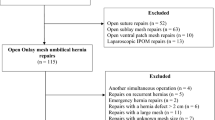Abstract
Background
Repair for a small (≤2 cm) umbilical and epigastric hernia is a minor surgical procedure. The most common surgical repair techniques are a sutured repair or a repair with mesh reinforcement. However, the optimal repair technique with regard to risk of reoperation for recurrence is not well documented. The aim of the present study was in a nationwide setup to investigate the reoperation rate for recurrence after small open umbilical and epigastric hernia repairs using either sutured or mesh repair.
Materials and methods
This was a prospective cohort study based on intraoperative registrations from the Danish Ventral Hernia Database (DVHD) of patients undergoing elective open mesh and sutured repair for small (≤2 cm) umbilical and epigastric hernias. Patients were included during a 4-year study period. A complete follow-up was obtained by combining intraoperative data from the DVHD with data from the Danish National Patient Register. The cumulative reoperation rates were obtained using cumulative incidence plot and compared with the log rank test.
Results and conclusions
In total, 4,786 small (≤2 cm) elective open umbilical and epigastric hernia repairs were included. Age was median 48 years (range 18–95 years). Follow-up was 21 months (range 0–47 months). The cumulated reoperation rates for recurrence were 2.2 % for mesh reinforcement and 5.6 % for sutured repair (P = 0.001). The overall cumulated reoperation rate for sutured and mesh repairs was 4.8 %. In conclusion, reoperation rate for recurrence for small umbilical and epigastric hernias was significantly lower after mesh repair compared with sutured repair. Mesh reinforcement should be routine in even small umbilical or epigastric hernias to lower the risk of reoperation for recurrence avoid recurrence.

Similar content being viewed by others
References
Helgstrand F, Rosenberg J, Bay-Nielsen M et al (2010) Establishment and initial experiences from the Danish Ventral Hernia Database. Hernia 14:131–135
Helgstrand F, Rosenberg J, Jørgensen LN et al (2010) Surgical treatment of ventral hernia. Ugeskr Laeger 172:1987–1989
Witherspoon P, O’Dwyer PJ (2009) Surgeons’ perspectives on options for ventral abdominal hernia repair: results of a postal questionnaire. Hernia 9:259–262
Helgstrand F, Rosenberg J, Kehlet H et al (2012) Reoperation for recurrence vs. clinical recurrence rate after ventral hernia repair. Ann Surg 256:955–958
Arroyo A, García P, Pérez F et al (2001) Randomized clinical trial comparing suture and mesh repair of umbilical hernia in adults. Br J Surg 88:1321–1323
Polat C, Dervisoglu A, Senyurek G et al (2005) Umbilical hernia repair with the prolene hernia system. Am J Surg 190:61–64
Arroyo A, Pérez F, Serrano P et al (2002) Is prosthetic umbilical hernia repair bound to replace primary herniorrhaphy in the adult patient? Hernia 6:175–177
Asolati M, Huerta S, Sarosi G et al (2006) Predictors of recurrence in veteran patients with umbilical hernia: single center experience. Am J Surg 192:627
Farrow B, Awad S, Berger DH et al (2008) More than 150 consecutive open umbilical hernia repairs in a major Veterans Administration Medical Center. Am J Surg 196:647–651
Wright BE, Beckerman J, Cohen M et al (2002) Is laparoscopic umbilical hernia repair with mesh a reasonable alternative to conventional repair? Am J Surg 184:505–508
Sanjay P, Ried TD, Davies EL et al (2005) Retrospective comparison of mesh and sutured repair for adult umbilical hernias. Hernia 9:248–251
Halm JA, Heisterkamp J, Veen HF et al (2005) Long-term follow-up after umbilical hernia repair: are there risk factors for recurrence after simple and mesh repair. Hernia 9:334–337
Aslani N, Brown CJ (2010) Does mesh offers an advantage over tissue in the open repair of umbilical hernias? A systematic review and meta-analysis. Hernia 14:455–462
Erritzøe-Jervild L, Christoffersen MW, Helgstrand F et al (2013) Long-term complaints after elective repair for small umbilical or epigastric hernias. Hernia 17:211–215
Bisgaard T, Kehlet H, Bay-Nielsen M et al (2011) A nationwide study on readmission, morbidity, and mortality after umbilical and epigastric hernia repair. Hernia 15:541–546
Helgstrand F, Jørgensen LN, Rosenberg J et al. (2013) Nationwide prospective study on readmission after umbilical or epigastric hernia repair. Hernia. doi:10.1007/s10029-013-1120-9.
Langer C, Schaper A, Liersch T et al (2005) Prognosis factors in incisional hernia surgery: 25 years of experience. Hernia 9:16–21
Bencini L, Sanchez LJ, Bernini M et al (2009) Predictors of recurrence after laparoscopic ventral hernia repair. Surg Laparosc Endosc Percutan Tech 19:128–132
Author information
Authors and Affiliations
Corresponding author
Additional information
The study was approved by the Danish Data Protection Agency (Reg. No. 2008-58-0020). Clinicaltrials.gov. ID: NCT01607801.
Rights and permissions
About this article
Cite this article
Christoffersen, M.W., Helgstrand, F., Rosenberg, J. et al. Lower Reoperation Rate for Recurrence after Mesh versus Sutured Elective Repair in Small Umbilical and Epigastric Hernias. A Nationwide Register Study. World J Surg 37, 2548–2552 (2013). https://doi.org/10.1007/s00268-013-2160-0
Published:
Issue Date:
DOI: https://doi.org/10.1007/s00268-013-2160-0




